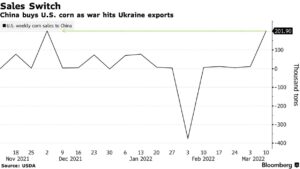China is on pace to meet its pledge to buy 12 million tons of US soybeans by the end of February, US Treasury Secretary Scott Bessent said on Wednesday, appearing…
Russian Grain Exports Persist, Albeit at Slower Pace, as China Turns to U.S. Corn
Bloomberg writer Megan Durisin reported yesterday that, “Grain exports from Russia are slowing but continue to flow, with ships calling at the nation’s ports even as the war in Ukraine rages on and fears over global food security increase.
“AgFlow, a Geneva-based crop data company, estimates about 73 vessels carrying agricultural staples like wheat departed Russia in the first two weeks of March, versus 220 during the same period last year. Sea/ by Maritech, another ship-tracking platform, estimates crop tonnage from the nation’s ports in the week to March 12 fell by half from the preceding seven days.”

The Bloomberg article stated that, “‘Following this week’s tenders, there is more confidence that wheat is available for export at an elevated price.’ Rabobank analysts said Wednesday in a note. ‘However, the situation remains deeply uncertain and shifting to this ‘new normal’ of greatly reduced Black Sea exports will still take time.'”
Also yesterday, Bloomberg writers Michael Hirtzer and Tarso Veloso Ribeiro reported that, “China is ramping up corn purchases from the U.S. as Russia’s invasion of Ukraine snarls grain exports and puts spring plantings in doubt, pushing prices higher in Chicago.
“The world’s top importer scooped up 200,000 metric tons of corn last week for shipment in the season beginning Sept. 1, U.S. Department of Agriculture data showed Thursday, the most since December. While China was only the fourth-largest buyer for the week, the sale was notable since the Asian country had been purchasing supplies from Ukraine. China was also the leading buyer of U.S. soybeans, picking up more than 800,000 tons.”

Meanwhile, with respect to crop production in Ukraine, Reuters writer Pavel Polityuk reported yesterday that, “Ukrainian winter wheat crops are in good condition and the country will have enough bread this year, Deputy Agriculture Minister Taras Dzoba said late on Wednesday.”
The article noted that, “APK-Inform agriculture consultancy said this week the area sown with Ukraine’s 2022 spring grain crops could fall 39% to 4.7 million hectares due to Russia’s military invasion.”
Last week, Ukraine President Volodymyr Zelenskiy urged farmers to plant as many fields as possible.
And a separate Reuters article from yesterday reported that, “Ukraine has started sowing spring grain in some areas but no mass sowing campaign has yet started, deputy agriculture minister Taras Vysotskiy told Reuters on Thursday.
He said it was not yet possible to forecast how much grain would be sowed in Ukraine, which has been invaded by Russian forces.
Amid the uncertainty, Reuters writer Nigel Hunt reported yesterday that, “The International Grains Council (IGC) on Thursday cut its forecast for Ukraine’s grain exports in the current 2021/22 season, noting ongoing conflict in the country had fuelled concerns about potential food security risks.
“Ukraine’s grain exports were revised to 47.8 million tonnes, sharply down from last month’s forecast of 62.8 million with the council noting projections were especially tentative and subject to significant uncertainty.”
Hunt added that, “Ukraine’s corn export outlook was cut to 21.0 million tonnes from 31.9 million while wheat exports were downwardly revised to 20.8 million from 24.5 million.
“The IGC also downwardly revised its forecast for Russian grain exports to 37.1 million tones from 37.7 million.”
Meanwhile, Reuters writer Maytaal Angel reported yesterday that, “The war in Ukraine is already resulting in rising food prices and a shortage of staple crops in parts of central Asia, the Middle East and north Africa, the United Nations International Fund for Agricultural Development (IFAD) said on Thursday.”
3. Assist vulnerable people, including those internally displaced. The war will push many into poverty & hunger. Countries must provide them w/ social safety nets.
— Maximo Torero (@MaximoTorero) March 17, 2022
4. Avoid ad hoc policy reactions. Banning food exports can boost domestic supply but will drive up global prices.
And Bloomberg News reported yesterday that, “‘What’s going on in Ukraine is going to change our whole approach, and our view on the future of agriculture,’ EU Commissioner for Agriculture Janusz Wojciechowski said in the European Parliament. ‘We have to have a return to food security.’
“The EU is working on measures that would allow fallow land to be used to grow protein crops to avert a scarcity of feed, Wojciechowski said. It’s also looking at offering support to the pig-meat industry, and studying a proposal to allow member nations to grant aid to farmers in a relaxation of state-aid rules, as happened during the pandemic.”
With respect to near-term agricultural production issues, Bloomberg writers Brian K Sullivan, Allison Nicole Smith, and Michael Hirtzer reported yesterday that, “The risk of major flooding in the fertile Red River Valley and continued snow cover across Minnesota and North Dakota threaten to delay planting across the region for weeks, U.S. government forecasters said in a call with reporters.”
.@NOAA #SpringOutlook 2022: Hydrologists predict minor-to-moderate flood risk throughout much of Eastern U.S. https://t.co/09cKRk7iE9 @nwscpc @nwsnwc pic.twitter.com/gxUG4xZ1i2
— NOAA Communications (@NOAAComms) March 17, 2022
.@NOAA #SpringOutlook 2022: 60% of the continental U.S. is impacted by #drought, marking the most significant U.S. #drought since 2013 https://t.co/09cKRk7iE9 @NWSCPC pic.twitter.com/K5GxrcyTVK
— NOAA Communications (@NOAAComms) March 17, 2022
And Reuters writer Karl Plume reported yesterday that, “A severe drought that has gripped parts of the western United States since mid-2020 is likely to persist or worsen this spring due to expected above-normal temperatures and below-normal precipitation, the National Oceanic and Atmospheric Administration (NOAA) said Thursday.”





